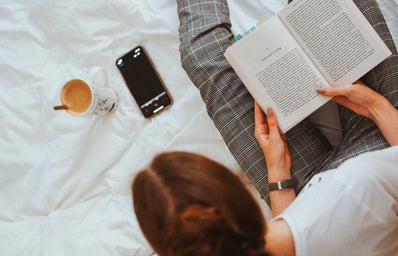My screen time reached an embarrassing high at the beginning of the pandemic. When the world shut down, leaving me at home with nothing to do, I found myself resorting to spending my days glued to my iPhone’s screen. Mornings were spent lounging in bed checking every social media app on my phone, refreshing my feeds and killing time on the explore pages. I then stayed up late at night channeling my cooped up energy into falling down YouTube rabbit holes. Even as I mindlessly watched playlists of videos, I knew that the excessive time I spent on my phone was a growing detrimental habit. I was spending six hours per day on my phone, and it felt like a toxic, yet unavoidable, result of quarantine.

When my first quarter of college began last fall, I snapped out of it and knew I needed to break my addiction to my phone. Wasting away a quarter of each day during the summer months of the pandemic didn’t have a huge effect on my life, but this lifestyle was no longer viable. I wanted to be able to tackle the school year head-on and allocate my time wisely between homework, clubs and free-time with my family. These college goals just weren’t possible given my reliance on social media apps.
I decided to set myself a strict goal and see if I could hold myself to it: Once school started, I was not going to use my phone for more than one hour per day.

Five months later, I’ve made my goal a reality by adopting several new habits into my daily routine. I’ve learned that simply setting a time limit on my social media apps does not do the trick, so I’ve put time into adjusting aspects of my lifestyle in order to keep my short screen time goal sustainable.
First, I identified the hour in the evening right before I go to bed as when I’m most susceptible to wasting time on my phone. This pattern was rectified by adding more structure to my nightly routine by filling it with self-care practices. For example, I started putting more effort into my skincare routine. Now, when I’m sleepy and start to reach for my phone, I instead go to the sink to begin with my cleansing, exfoliating and moisturizing. By the time I’m done pampering my skin, the urge to check my phone is forgotten, and I’m more inclined to just continue getting ready for bed. Additional alternatives to spending time on skincare have been relaxing practices like journaling and reading. Each of these habits replaces my screen time with soothing and productive nightly steps that make unwinding easier at the end of the day.

I next realized that a huge fraction of my screen time was due to playing YouTube videos while preparing and eating my meals. Keeping content open on my phone while I cooked felt like a great way to multitask, but in reality, it was making my time in the kitchen take longer, and I wasn’t even truly appreciating the videos I was “watching.” I also confronted the fact that binge-watching YouTube whenever I ate was taking away from my enjoyment of my meals. Adjusting my behavior was actually an easy fix. I intentionally began turning on some music in the background of my cooking as an alternative to watching videos, and I started trying to schedule my meals with other members of my household. Soon, I reaped the benefits of efficiency in the kitchen, gained more meaningful meals and of course, achieved less time wasted on my device.
The third key change which helped me learn to limit my screen time was unfollowing lots of accounts on all of my social media platforms. I noticed that I was following many influencers and pages that were just flooding my apps with extraneous content, and they weren’t adding anything beneficial to my daily routine. Going through Instagram, Twitter and Snapchat and weeding out dozens of accounts has meant way less random content sucking me into endless cycles of scrolling. Nowadays, even when I click on social media apps, each visit to a site is usually shorter because I only check in on the posts which are most important to me. My purging of social media accounts has totally helped me quell lingering feelings of FOMO when I’m not checking my phone and has proven essential to maintaining my strict one-hour-per-day phone policy.

With these three core adjustments, I’ve managed to keep my screen time down to one hour per day for the entire school year so far. I’ve made huge strides in loosening my reliance on my phone and seen definite improvements in my productivity and mental health along the way. I’m convinced that spending less time addicted to social media has made staying on top of my college assignments easier, and I’m getting far more sleep than I ever did during high school. Though I haven’t entirely quieted the nagging voice in my head telling me to check my notifications, I’m proud of the steps I’ve made and hope to continue shedding my dependency on technology throughout 2021.



